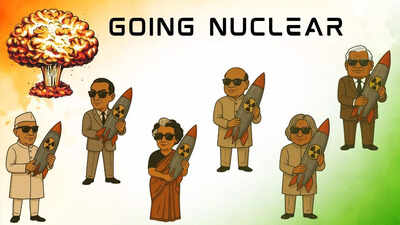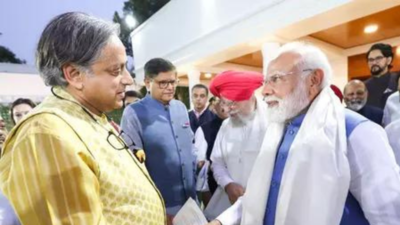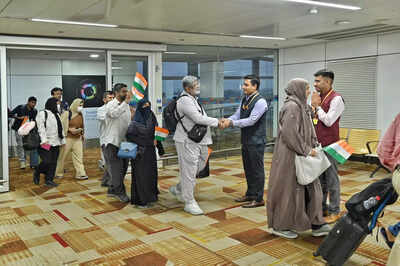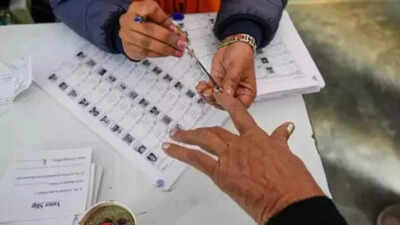Donald Trump strikes Iran: How India got its nukes – and defied US and other nuclear-haves | India News

There’s a running meme on X, the hellhole formerly known as Twitter, where a doctor asks a patient: “Do you have a history of mental illness in your family?” To this, the patient replies: “I have an uncle who believes Iran is close to a nuclear weapon for the last 50 years.”Perhaps that’s why Operation Midnight Hammer – a blow-by-blow remake of Top Gun: Maverick – was carried out with such haste that even half of Donald Trump’s base were still railing against it as the bombs dropped on Fordo, Natanz, and Isfahan.While Iran’s Godot-like wait for nuclear weapons continues, it’s illustrative to see how India, a nation that didn’t evoke very warm feelings from Uncle Sam in the past, became a nuclear superpower. How did a newly freed, partition-bruised, socialist-leaning, and largely illiterate country go from famine queues and imported milk powder to becoming one of the world’s most improbable nuclear powers?The truth is that politicians of various vintages played a part, irrespective of their worldview or political leanings. Every one of them was of the opinion that the Ayatollahs of Potomac (a delightful term coined by TOI legend K Subrahmanyam, the father of the current external affairs minister) couldn’t be the only ones with the power of the sun in the palm of their hands.As George Fernandes, the erstwhile Defence Minister of India in the Vajpayee government, summed up this grit: “I am not a former socialist; I am a socialist. I am not a former pacifist; I am a pacifist. I am even today an anti-nuclear weapon man. But as a defence minister of the country, I will do whatever is best to protect its border, and if that means nuclear bomb, then why not?”When pressed on how one could do so at the risk of contradicting oneself, Fernandes dug deep into the Lord Krishna rationale that one’s dharma trumps all contradictions, pointing out: “Yes, even at the cost of contradicting oneself, even at the cost of dying. If the security of the country requires me to die, I shall die. It’s about being realistic. It’s about being patriotic.”While with the benefit of hindsight, it might seem inevitable that the land that gave the world the Bhagavad Gita would come up with nuclear weapons, here’s the tale of how it went down.
The Science Segue

What is a nuclear weapon — and why do countries want one?Let’s say you haven’t seen Oppenheimer, skipped physics class, and think “fusion” is what happens when you have tandoori gravy momos.To understand nukes, we need to rewind to 1905, when a wild-haired Swiss patent clerk named Albert Einstein wrote four papers that changed science forever.One of them suggested that mass and energy are two sides of the same coin. A few months later, he dropped a tiny but terrifying equation: E = mc². That means energy equals mass times the speed of light squared. Since light travels really fast — about 300 million metres per second — squaring it makes even a small amount of mass release a huge amount of energy.So, how do we turn that into a weapon? That’s where nuclear physics steps in.Certain heavy atoms like uranium-235 or plutonium-239 are naturally unstable. If you shoot a neutron at them, they split — releasing heat, radiation, and more neutrons. Those neutrons hit other atoms, which split too. It’s called a chain reaction — kind of like a viral WhatsApp message, but instead of arguments, you get a mushroom cloud.That’s how atomic bombs work. The ones dropped on Hiroshima and Nagasaki used two designs:
- Gun-type: smash two pieces of uranium together
- Implosion-type: use explosives to compress plutonium until it explodes
Both use Einstein’s idea: a little mass disappears, and a huge burst of energy takes its place. There’s also the hydrogen bomb, which is even more terrifying, but beyond the scope of this piece.By the 1960s, nuclear weapons were the privilege of a select five—America, the Soviet Union, Britain, France, and China—enshrined as permanent members of the global atomic aristocracy, the kind that liked to invade Vietnam in their spare time and host disarmament conferences in their downtime. There is something about nukes and their miasma. Once you have them, you don’t want others to get them. You start doing everything in your power to stop anyone else from joining this super-exclusive club, because deterrence is always more comfortable when it’s a monopoly.And then in 1974, India came knocking—with Smiling Buddha, gatecrashing the party with a silent explosion in the Rajasthan desert. If Israel was the nuclear sphinx, India was the grinning intruder who didn’t wait for an invitation.
Act I: Nehru’s Noble Atom and Bhabha’s Quiet Calculations

How did a socialist, beggared and non-aligned country acquire nuclear weapons? It all started with Pandit Jawaharlal Nehru, the Fabian socialist who wasn’t beyond making a Faustian deal if it was for the nation’s betterment. While he publicly championed atomic energy for rural electrification, privately he laid the groundwork for a weapons programme.Enter Homi Jehangir Bhabha—part physicist, part institution-builder, all ambition, played with élan by Jim Sarbh in the heavily fictionalised Rocket Boys, whose cheekbones are capable of setting off a different sort of chemical reaction.A Cambridge-trained genius with a velvet accent, Bhabha envisioned a self-sufficient Indian nuclear complex. He set up the Atomic Energy Commission in 1948 and Trombay’s Bhabha Atomic Research Centre (BARC) soon after.His three-stage nuclear plan was audacious: heavy water reactors for plutonium, fast breeder reactors for more fissile material, and eventually, thorium-based systems.In 1955, India obtained the CIRUS reactor from Canada, with heavy water courtesy the United States—both under the Atoms for Peace programme. It was a masterclass in strategic procurement.
Act II: The Dragon Strikes, the Buddha Smiles

Enter the dragon. In 1962, Chinese troops stormed Indian posts in Ladakh and Arunachal. The result wasn’t just military humiliation; it was psychological trauma. Nehru aged a decade overnight. And two years later, when China tested a nuclear bomb in Lop Nur, India realised it wasn’t just behind—it was vulnerable.And then came the prodigal daughter. Indira Gandhi had no qualms about the world or any delusions about power. By the early ’70s, the scientific community—led by Raja Ramanna, P.K. Iyengar, and M.R. Srinivasan—had weaponised the plutonium harvested from CIRUS.On May 18, 1974, India conducted its first nuclear test in Pokhran, Rajasthan. Codenamed Smiling Buddha, because what better name for a nuclear bomb than the progenitor of peace, the device yielded around 8 kilotons, billed as a “peaceful nuclear explosion”. Canada fumed and threw a Trudeau-level fit. The US imposed sanctions. But much like she did when Richard Nixon threatened her during the Bangladesh Liberation War, Indira Gandhi didn’t flinch.
Act III: Recessed Deterrence—Weapons Without Words
From 1974 to 1998, India lived in nuclear ambiguity. We had tested a bomb—but never declared a doctrine. This era, later dubbed “recessed deterrence”, saw India perfect the art of silent readiness.Prime Ministers like Morarji Desai were openly anti-nuclear. Others, like Rajiv Gandhi, were more nuanced—calling for universal disarmament while funding missile programmes.In this period, India commissioned the Dhruva reactor for weapons-grade plutonium. Ballistic missiles like Prithvi and Agni were tested under the Integrated Guided Missile Development Programme, overseen by Dr. Abdul Kalam.Still, New Delhi avoided another test. The 1985 NPT Review Conference slammed the door shut on India’s membership. But India refused to sign a treaty that said: “You can’t have nukes, but the P5 can.”
Act IV: Narasimha Rao ’s Nuclear Poker
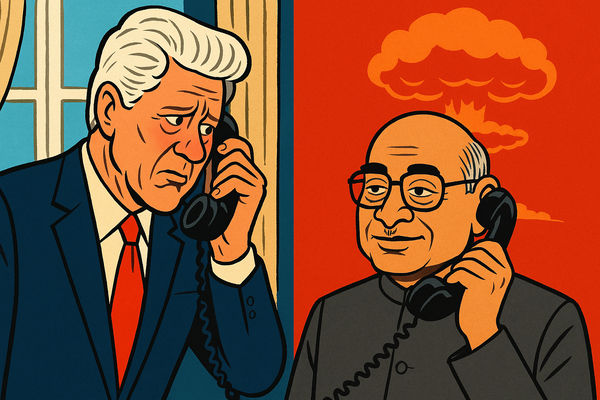
By the 1990s, India was ready. And P.V. Narasimha Rao, India’s philosopher-king of pragmatism, knew it. In 1995, with the Clinton administration distracted by Yeltsin’s vodka diplomacy and Pakistani warlords, Rao greenlit preparations for Pokhran-II. Shafts were drilled. Scientists were mobilised. Dr. Kalam, Dr. R. Chidambaram, and their teams stood by.Then, American satellites picked up movement. The CIA raised alarms. A New York Times exposé spooked Washington. Clinton dialled Delhi. Rao, deadpan as ever, stonewalled. The tests were paused.But he didn’t stop the programme. Instead, he ensured everything stayed intact—ready for a more audacious successor.As legend has it, Rao whispered to Atal Bihari Vajpayee before leaving office: “Everything is ready. You just have to press the button.”Rao never took credit. But when the mushroom clouds rose in 1998, they bore his blueprint.
Act V: Pokhran-II—India Goes Loud
On May 11 and 13, 1998, India conducted five nuclear tests. Codename: Operation Shakti.This time, it wasn’t a “peaceful” explosion. It was a declaration. Fission and fusion devices were tested. Thermonuclear capability was claimed (though some scientists later debated the yield).Prime Minister Vajpayee announced: “India is now a nuclear weapons state.” Sanctions came. Condemnations followed. India shrugged.The team that delivered this feat:
- Dr R. Chidambaram – chief scientific coordinator
- Dr. Abdul Kalam – DRDO’s key missile man
- K. Santhanam – test range commander
- Anil Kakodkar, V.S. Arunachalam, S.K. Sikka – technical leads
Pakistan tested six devices in response. South Asia was officially a two-bomb region. But India’s message was clear: deterrence, not domination.
Act VI: From Outlaw to Operator—The Indo-US Nuclear Deal
Having proven its capabilities, India now wanted respect.In 2005, under Manmohan Singh, India signed the Indo-US Civil Nuclear Agreement with President George W. Bush. It was historic. For the first time, a non-NPT country gained access to civilian nuclear trade.The deal was backed by the US Congress, the IAEA, and the NSG. It marked India’s transformation from global pariah to trusted partner—without dismantling a single warhead.Critics cried foul. Proponents hailed it as a realpolitik victory. For India, it was simple: we earned the bomb. Now we wanted the fuel.
Epilogue: From Fallout to Future
The bomb was never the endgame. It was the insurance policy. A radioactive reminder that India wouldn’t be bullied into compliance or bribed into silence. The scientists were the magicians, the politicians their illusionists. But behind them stood a civilisation that never wanted conquest—only the right to decide its destiny. From Bhabha’s lab bench to Vajpayee’s launch pad, India’s nuclear odyssey was built on a foundation of paradoxes: peaceful atoms turned potent, idealism wrapped in pragmatism, and restraint forged through power.Today, India’s nuclear arsenal isn’t about posturing. It’s about posture—calm, calculated, credible. We built the bomb not to drop it, but to make sure no one else could.So the next time someone scoffs at Indian statecraft, remind them: we cracked open the atom, outfoxed the CIA, kept our doctrine unspoken, and still walked into the world’s nuclear club with our head held high. We didn’t explode to destroy. We exploded to exist. And that, in the final analysis, is how you detonate a dream.

